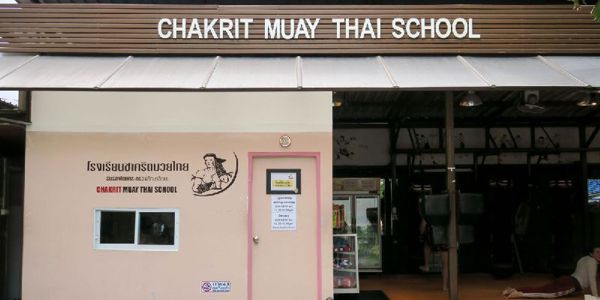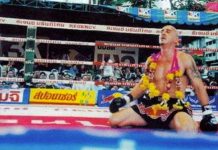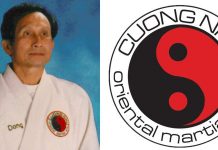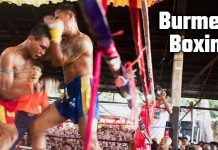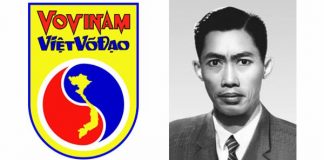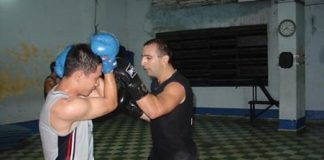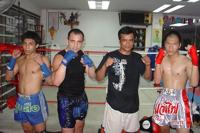 Coach Adjan Chakrit teaches Muay Thai Chaki style, he moves in circles, holding up the focus mitts, he calls out the commands. “One, one two.” I throw a straight left, right combination. “Four!” That means, left, right, hook, straight. This part is easy for me. I have been boxing since I was twelve years old. But now he calls for two kicks on the right side, followed by two kicks on the left side. The energy required to throw a kick, versus a punch is incredibly draining. My balance is off now. My weight is all over the place. More punches, more kiks, a series of elbow strikes.
Coach Adjan Chakrit teaches Muay Thai Chaki style, he moves in circles, holding up the focus mitts, he calls out the commands. “One, one two.” I throw a straight left, right combination. “Four!” That means, left, right, hook, straight. This part is easy for me. I have been boxing since I was twelve years old. But now he calls for two kicks on the right side, followed by two kicks on the left side. The energy required to throw a kick, versus a punch is incredibly draining. My balance is off now. My weight is all over the place. More punches, more kiks, a series of elbow strikes.
“Block!” he yells.
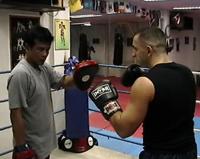 Instinctively, I drop my elbow to protect my mid-section. Wrong move! His kick catches me just below the ribcage. This is Muay Thai, not boxing. I have to remember to block by bringing up my shins, instead of bringing down my elbows.
Instinctively, I drop my elbow to protect my mid-section. Wrong move! His kick catches me just below the ribcage. This is Muay Thai, not boxing. I have to remember to block by bringing up my shins, instead of bringing down my elbows.
“Front kick.” He yells, before I regain my balance.
“Knee, knee, straight, block.”
In addition to dealing with the unusual commands in the foreign language, I am fatigued, and my brain is not working as sharply as it should be. There is a long delay before I can react to the commands. Once again, the coach’s shin catches me in the mid-section.
Muay Thai is an ancient martial art which a lot of people believe was developed first in Cambodia, and later adapted by Thailand. The Khmers are angry that the Thais have put their name on the art. Monks and scholars I have spoken to in Thailand believe it is very possible that many of the techniques or refinement of this form of combat were adopted form Cambodia. It is certain, however, that there was some type of unarmed combat technique in Thailand before the Khmer influence.
Written records of Muay Thai date back approximately five hundred years. At that time the bouts had very few rules. The competitors fought essentially bare-fisted with their hands wrapped in ropes.
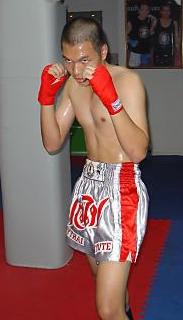 During the 1920s and 1930s, when Thailand was modernizing, the art was further refined into a professional sport. The first stadiums were built and the ring and gloves were added. This period is really the birth of modern Muay Thai. Today, Muay Thai is a big professional sport in Thailand, with somewhere in the order of 60 – 90 thousand professional fighters. In the west, we would expect good professional fighters to have worked their way up from the amateur circuit, but in Thailand there isn’t much of an amateur Muay Thai circuit. For the most part, Thai people can’t see the point of getting beat up for free. As a result, there is nearly exclusively professional Muay Thai.
During the 1920s and 1930s, when Thailand was modernizing, the art was further refined into a professional sport. The first stadiums were built and the ring and gloves were added. This period is really the birth of modern Muay Thai. Today, Muay Thai is a big professional sport in Thailand, with somewhere in the order of 60 – 90 thousand professional fighters. In the west, we would expect good professional fighters to have worked their way up from the amateur circuit, but in Thailand there isn’t much of an amateur Muay Thai circuit. For the most part, Thai people can’t see the point of getting beat up for free. As a result, there is nearly exclusively professional Muay Thai.
Muay Thai has been added to the SEA Games (South East Asian) and it will most likely be added to the Asian Games, which will probably promote an amateur version of the sport. Thailand and Cambodia have had a long running feud because Cambodians feel the art should be called Bradal Serey or free fighting. They are angry about the fact that in Thailand branded the art as Muay Thaii. As a result, Cambodia refuses to compete in the Muay Thai championships in the SEA Games and refuse to join the World Muay Thai Council which governs professional Muay Thai. As a result, Cambodia can’t fight for the championship. Vietnam and Lao are both Communist and support Cambodia, by also refusing to compete in Muay Thai in the South East Asian Games.
Training in Vietnam a few weeks ago, I discovered that they didn’t have any kickboxers or professional fighters in the whole country. Consequently, their refusal to compete in the SEA games is not so significant.
Thailand and the Philippines are doing extremely well on the international fighting circuits, in the lower weight divisions. Japan hosts the K-1 which is basically the Super Bowl of professional kickboxing. Now, they have opened smaller weight divisions to allow Southeast Asians to compete. Japan is, in a way, becoming neutral ground for the politically charged sport of Muay Thai. There is also the ISKA, a professional kick boxing league, based out of the USA, which is also seen as a neutral title. Cambodia, Vietnam, and Lao could compete in the ISKA or K-1 without using the name Muay Thai. While Thailand has been quick to join international boxing leagues such as WBA, WBO and others, the neighboring Southeast Asian nations have been reluctant.
Although Muay Thai encompasses a lot of religious, cultural, and political concepts, in practice, it is essentially Thai kickboxing. They hit with punches, kicks, knees, and elbows. The kicks are very special because they are hitting with the shins, not the feet. The elbows and shins are very hard and can cut you wide open. When someone tries to kick you with their shin, you can’t use your hand or your arm to block because you will get hurt. The way we block is by using our shin bone. You raise your leg up and take the impact shin to shin. You can imagine how much that hurts. As a result, a lot of the Muay Thai training deals with toughening the shins, deadening the nerves, and building up scar tissue. We call it hardening the shins.
In provincial training camps you will find poor Thais who see boxing as a way of earning money to help their family. They go to live in a camp and become pat of the stable of fighters. The camp arranges fights for them and takes a percentage of the purse. In return, the boys get free room, board, and training. In these camps you will see people doing all manner of crazy exercises to harden their shins quickly. They kick trees, kick bamboo, or kick metal poles. At night they sit around hitting their shins with sticks or with bottles. They smear all sorts of traditional medicines, potions and lotions, on the skin to quicken this hardening process. This type op training does work. They can go from zero to totally hardened shins in about 90 days, but it is a terrible experience, and the shins will be all cut, open, bleeding, and infected the whole time.
Modern coaches, such as my Bradal Serey (Pradal) coach in Cambodia, Paddy Carson, believes that your shins should just be allowed to harden naturally, over time by kicking the pads and kicking the bag. This is the same as we do for our hands and elbows.
In hardcore gyms the bags are hard to help you toughen up. In some of the foreigner gyms, the bags are softer and the coaches will do things like fall down or act like you have hurt them to pump you up and make you feel good. But take it with a grain of salt. Remember you re paying them a lot of money for that praise.
When you come to Thailand, you will have the choice between training in Bangkok or training in the provinces. If you train in the provinces you will be surrounded by poor Thai guys trying to earn money for family. Living conditions will be difficult. Training will be Spartan, but not necessarily better. The coaches in the provincial camps aren’t usually trained as coaches. They were chosen because they were winning fighters. Champion fighters aren’t necessarily the best coaches.
Provincial Thai people are very welcoming and will probably invite you to train with them. They may not charge you anything and just ask that you contribute for food. A provincial camp could be a great cultural experience, but if you are serious about learning to fight, Bangkok, Chiang Mai, Pattaya, or one of the more developed areas may be better for you. In a provincial camp, if you don’t know how to box already, you may not learn anything. Your training will consist of a lot of running and bouncing on tiers or jumping rope. You will be told to kick the bag but probably won’t be taught HOW to kick the bag. You may or may not get face time with the coach in the ring, working the pads. And you won’t get a lot of instruction. Also, if you don’t speak Thai, they probably won’t be able to communicate with you.
If you train in Bangkok, the average cost seems to be about seven to eight thousand Baht per month. And that is just for your training. Food and lodging are extra. The advantage is that a coach is assigned to you and get a lot of one-on-one instruction. At Muay Thai Chakrit, where I have been training, I can have as many rounds with my coach on the pads as I want. We usually do three or four rounds of just hands and two of kicks. In better gyms, the coach will also watch you shadow boxing and working the bag, refining your technique. Some gyms actually offer courses where you can learn step by step and even take exams and earn certificates. But many of the gyms in Thailand which cater to foreigners are making the assumption that you have had some training before. And in fact, it is a valid assumption. A lot of the foreigners are here because they are competing in MMA or Muay Thai in their home country and want to get some training experience in Thailand. So, the training in the gym is focused on practice and conditioning and refining technique, but not necessarily on teaching step-by-step, from the ground up.
Training in the other developed cities of Thailand can be much cheaper than training in Bangkok, but may offer the same quality of instruction. If you train in Chiang Mai there are live in camps which are as cheap as 8,000 to 10,000 Baht per month including your lodging
“Muay Thai is not just about fighting for money. It is our art, and I believe Thai people need to practice it. If we don’t, we will lose it.” Said Bom Apiwat, a university-bound student, practicing Muay Thai in Bangkok. In the remote parts of Thailand, professional boxing is seen as a last-ditch effort to get out of poverty, but a new generation of Thai young people are joining expensive gyms in Bangkok, training alongside crazy Farang (foreigners) training for the love of the art.
“I want to go to college and work in tourism, so I can travel the world.” Says Bom. “But first, I want to have at least one professional fight, so I can have the experience.”
Having experience in pro boxing or MMA can be a double edged sword when you are training in Thailand. While you are here to learn their art, you may not want to lose yours.
One of the arguments I get into with my coaches is that they want me to turn my hand over when I hook. Professional boxers don’t turn the hand over on a hook. My Bradal Serey coach in Phnom Penh, Paddy Carson also believes that the hook should not be turned over. He believes the reason all of the Asian martial arts turn the hand over on the hook is because their only experience in the past was amateur boxing. Whatever the reason, I don’t want to undo the things I do which work for me. I want the coaches to improve my kicks and elbows and knees but leave my hands alone.
The next argument was that they wanted me punching form way out, more than eighteen inches. But in boxing, I throw hooks and upper cuts from three inches. Working the pads the way they had me doing it in Thailand I was throwing out my shoulder. Some coaches told me that you can’t use the three inch punch in Muay Thai because you will get hit with knees and elbows. Now, I am waiting to see; are they telling me this because it is right, or telling me this because this is what they have always done? This is often the question you have to ask when you are training in Thailand; are we training to be more effective fighters or training to learn the art of Muay Thai better?
Today, the argument was that the coach said I was pressing him too much when we were working the pads in the ring. Every time I hit, I slide forward a bit. I do this to keep my weight moving into the punches and to make distance as an opponent will often back up when being hit. He said, “no you shouldn’t be moving forward like that.” But again this is a strategy that works for me. If I stay at a distance, the kicker will have an advantage. By coming in close, I can neutralize the kicker’s advantage and maximize my strengths which are boxing and grappling. This is what I have done in kickboxing in other countries. But again, I can’t say for certain that I am right, because maybe in Thailand, with the knees and elbows, this is not the best strategy. What I need, is to hear from the coach he has done research, and thought it through, and made an analysis leading to an answer based on fact, rather than “We teach you to do it this way because we have always done it this way.”
You must be aware that a lot of coaches train everyone the same way. A good coach needs to consider the strengths and weaknesses of the fighter and tailor each fighter’s training to his abilities. Everyone is not a 19 year old Thai guy who weighs 60 kgs and has 0% body fat. A lot of the foreigners training in Thailand are heavyweights and tend to be in their late twenties or early thirties. In fact in my gym, the average age of foreigners is probably around 35. And most are my size or larger. Nearly all have experience in another martial art, boxing, kickboxing, or grappling.
You need to constantly ask your coach why you are doing this or that. Make sure what they are teaching you will work for you.
For example, the coaches wanted me to bounce. They said, “You have to bounce. Muay Thai fighters bounce.” I said, “no way!” I weigh too much. Bouncing would destroy my knees and I would tire out in less than one round. If you watch K-1 those guys don’t bounce if they don’t want to. You have to fight your fight.
Training in Thailand is a great experience. When you come here, you are free of all the other distractions in your life, like working, and you can concentrate on training, eating, and sleeping. If you chose a good gym or great one, either way, you will be getting hours upon hours of training which you never had in your home country. You don’t have to be rich to come to Thailand. The flight is a bit pricey, but once you land, everything is cheap. Excellent Thai food can be had for less than one dollar per meal. Lodging can be found for between three and five thousand Baht per month. Don’t wait till you are rich, or you will never come. Just hop on a plane and get in the ring.
Martial Arts Odyssey: Muay Chakrit Part 1

